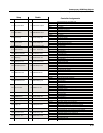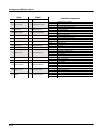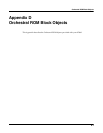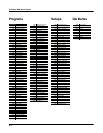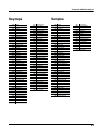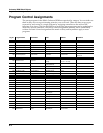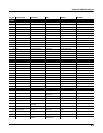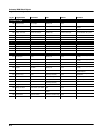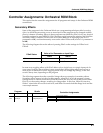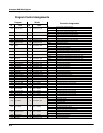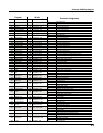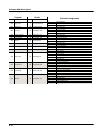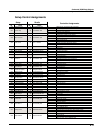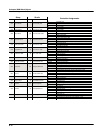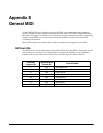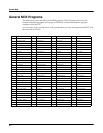
Orchestral ROM Block Objects
Controller Assignments: Orchestral ROM Block
D-7
Controller Assignments: Orchestral ROM Block
This section lists the controller assignments for all programs and setups in the Orchestral ROM
sound block.
Secondary Effects
Some of the programs in the Orchestral block use a programming technique called secondary
effects, in which the processing on one or more layers of the program can be changed with the
press of a button. Secondary effects in these programs are enabled by PSw2 (or by any physical
controller assigned to send MIDI 29). PSw2 acts as a toggle between the primary effect and the
secondary effect. It switches off one of the two FXBus sends on an Input page (sets its Lvl
parameter to Off), and simultaneously turns on the other FXBus send (sets its Lvl parameter to
0.0 dB).
The following diagram shows the effect of pressing PSw2 on the settings for FXBus1 and
FXBus2.
In most cases, toggling effects with PSw2 affects only a single layer on a single input pair. In
some cases, however, the switching is more complicated, and toggling effects moves one or
more layers to different FX buses. Toggling effects may also change EQ settings, or the Aux
reverb’s decay time, depending on the program.
The following segment from the controller listings shows an example of secondary effects.
Secondary effects appear in italics. In this example, when PSw2 is off, the program’s input
routings result in a room reverb effect, Slider B controls the wet/dry mix of this reverb. When
PSw2 is on, the routing changes, resulting in a flange effect. In this case, Slider B is inactive,
Slider C controls the aux room reverb level, and Slider D controls both the flange level and the
crosscouple amount.
PSw2 Status
Value of Lvl Parameter on Input Page
FXBus1 FXBus2
Off 0.0 dB Off
On Off O.0 dB
Program Studio
Controller Assignments
ID Name ID Name
999 SuperSynth 9 RmFlgChDly Room
B room1 reverb wet/dry
C aux room reverb level
D flange level, flange Xcouple
PSw2 toggle: room1 reverb/flange



